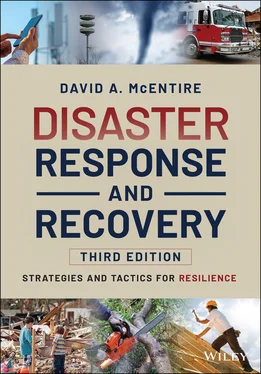David A. McEntire - Disaster Response and Recovery
Здесь есть возможность читать онлайн «David A. McEntire - Disaster Response and Recovery» — ознакомительный отрывок электронной книги совершенно бесплатно, а после прочтения отрывка купить полную версию. В некоторых случаях можно слушать аудио, скачать через торрент в формате fb2 и присутствует краткое содержание. Жанр: unrecognised, на английском языке. Описание произведения, (предисловие) а так же отзывы посетителей доступны на портале библиотеки ЛибКат.
- Название:Disaster Response and Recovery
- Автор:
- Жанр:
- Год:неизвестен
- ISBN:нет данных
- Рейтинг книги:5 / 5. Голосов: 1
-
Избранное:Добавить в избранное
- Отзывы:
-
Ваша оценка:
- 100
- 1
- 2
- 3
- 4
- 5
Disaster Response and Recovery: краткое содержание, описание и аннотация
Предлагаем к чтению аннотацию, описание, краткое содержание или предисловие (зависит от того, что написал сам автор книги «Disaster Response and Recovery»). Если вы не нашли необходимую информацию о книге — напишите в комментариях, мы постараемся отыскать её.
The new edition of the standard textbook in the field, updated with new studies and practical guidelines for reacting to the complexities of today’s disasters Disaster Response and Recovery: Strategies and Tactics for Resilience
Disaster Response and Recovery: Strategies and Tactics for Resilience, Third Edition
Disaster Response and Recovery — читать онлайн ознакомительный отрывок
Ниже представлен текст книги, разбитый по страницам. Система сохранения места последней прочитанной страницы, позволяет с удобством читать онлайн бесплатно книгу «Disaster Response and Recovery», без необходимости каждый раз заново искать на чём Вы остановились. Поставьте закладку, и сможете в любой момент перейти на страницу, на которой закончили чтение.
Интервал:
Закладка:
Although disasters result from the interaction of both hazards and vulnerability, the two concepts have distinct implications for practical application. Because it is not always possible to prevent or control hazards, people and organizations should give extra attention to efforts that reduce their vulnerability to disasters (McEntire 2005). For this reason, the knowledge and expertise of individuals that are employed in emergency management and related professions are required to deal effectively with mass emergencies, disasters, calamities and catastrophes ( Figure 1‐1).
From an academic standpoint, emergency management“is the study of how humans and their institutions deal with hazards, vulnerabilities and the events that result from their interaction” (Jensen, 2013). The emergency management discipline accordingly seeks to create and disseminate knowledge about what people and organizations can do to diminish the frequency and impact of disasters. From a practical perspective, emergency management“is the managerial function charged with creating the framework within which communities reduce vulnerability to hazards and cope with disasters” (Blanchard et al., 2007, p. 4). This suggests the need for highly educated and trained individuals who are given the responsibility to advance the goals of reducing disasters and reacting to them in an effective manner. These professionals are known as emergency managers; they have a keen “interest in disasters and a strong desire to alleviate the suffering of those impacted” by these adverse events (Phillips, Neal and Webb 2017, p. 106).

Figure 1‐1 Emergency management personnel often attend meetings to prepare for future disasters.Michael Rieger/FEMA.
http://www.spc.noaa.gov/faq/tornado/ef‐scale.html
Put differently, emergency managersare public servants that help jurisdictions reduce the liabilities that lead to disasters. These employees (governmental and even non‐governmental) also work closely with many concerned stakeholders and endeavor to build capabilities to deal more effectively with hazards and disasters. Such activities are commonly described as the disaster life cycle or the four phases of emergency management. These proactive and reactive efforts include mitigation, preparedness, response and recovery:
Mitigation refers to several priorities and actions, including risk reduction, loss minimization, and/or the alleviation of potential negative impacts associated with disasters. Careful land‐use planning, improvements in building design and construction, and a reliance on insurance to cover the costs associated with disasters are examples of mitigation activities.
Preparedness implies efforts to increase readiness for a disaster. Examples of preparedness initiatives include the creation of laws/ordinances, the acquisition of grants or other resource s, and various measures such as planning, training, exercises and community education.
These two phases ‐ mitigation and preparedness ‐ should be given the highest priority in the emergency management profession today. For this reason, emergency managers must not be seen solely as an extension of first responders— our wonderful police, fire, and emergency medical personnel who serve so valiantly when emergencies occur. The goals of emergency managers are more proactive and encompassing than emergency response, even if they do overlap with the objectives and operations of these heroic public servants at times.
However, because it is impossible to eliminate all disasters, emergency managers must also be involved in disaster response and recovery operations. Disaster responseincludes actions “taken immediately before, during, or directly after an emergency occurs, to save lives [and] minimize damage to property” (Godschalk, 1991, p. 136). Examples of disaster response functions include
Warning people of severe weather
Evacuating those who are assumed to be at risk
Sheltering the affected population
During response operations, it may also be necessary to provide emergency medical care, relay information to the public, and manage the arrival of donations and volunteers.
Disaster recovery, in contrast, consists of actions “to return vital life support systems to minimum operating standards and long‐term activity designed to return life to normal or improved levels” (Godschalk, 1991, p. 136). This incorporates efforts to repair homes damaged by disaster and rebuild community infrastructure such as power lines, roads, and courthouses.
Each of the phases described in this section is closely related to the others (Neal, 1997). For instance, it is difficult to separate mitigation from preparedness as both are proactive measures to reduce the impact of disaster. Preparedness also has a significant influence upon the success of post‐disaster management since it enables a community to anticipate response and recovery needs. In addition, it is difficult to determine when response ends and when recovery begins. For instance, are damage assessment and debris removal response functions or part of disaster recovery operations? Also, during recovery, it is vitally important that steps be taken to prevent future disasters or minimize their potential impact. Instead of simply rebuilding homes that have been damaged by a flood or a tornado, it may be necessary to relocate these structures to safer areas or implement more stringent construction requirements (e.g., improved anchors, hurricane straps, safe rooms, etc.). For these reasons, the word “phases” may be somewhat misleading. With this in mind, it may be advisable to substitute “phases” with the term “functional areas” or “functional activities.” Also, these “phases” or functional areas or activities of emergency management do not appear or proceed in a neat, linear fashion. They occur and unfold with a degree of complexity, so it is sometimes difficult to separate them conceptually.
It is also imperative that emergency managers are aware of other important terminology related to their profession. Due to the rising threat of terrorism and the advent of homeland security, new lexicon was introduced in emergency management. After the 9/11 terrorist attacks, Homeland securitywas defined as “a concerted national effort to prevent terrorist attacks within the United States, reduce America’s vulnerability to terrorism, and recover from and minimize the damage of attacks that do occur” (Office of Homeland Security, 2002, p. 2). It is easy to see that this concept is related to emergency management. But, this concept is slightly different in that it also encompasses other distinct terms such as prevention and protection. Preventionrefers to efforts to stop the commission of terrorist attacks. It includes the gathering of intelligence, counterterrorism operations, and border control functions among others. Protection, on the other hand, is more concerned about actions that discourage attacks through increased security measures or efforts to minimize damage if such attacks cannot be always prevented in the first place. The reliance on guards, fences, video surveillance, and access control to sensitive locations falls into this category. As can be seen, it is likely that emergency managers and others in homeland security will work together to deal with all types of emergencies, disasters and terrorist attacks.
1.1.2 Preview of Disaster Response and Recovery
As indicated by the title, this book describes strategies and tactics to improve the management of disaster response and recovery operations. This decision is not meant to deny the value of functions relating to mitigation, preparedness, prevention and protection. It is instead based on the assumption that there is a need for a comprehensive textbook about post‐disaster activities. Although there are great works on this subject already, it is necessary to have more current information and not just approach the material from a pure academic or practical standpoint only. For instance, it is important to note that response and recovery operations have changed significantly over the past few decades and even substantially in recent years. The informative research generated by disaster scholars over the past several decades likewise must also be integrated with the lessons gained from the extensive experience of professional emergency managers. Furthermore, there is a dire need to further educate government leaders and public servants in order to avert the repetition of mistakes made after many disasters. Nevertheless, this book may also be of use to corporate leaders or humanitarian workers who are also involved in response and recovery operations.
Читать дальшеИнтервал:
Закладка:
Похожие книги на «Disaster Response and Recovery»
Представляем Вашему вниманию похожие книги на «Disaster Response and Recovery» списком для выбора. Мы отобрали схожую по названию и смыслу литературу в надежде предоставить читателям больше вариантов отыскать новые, интересные, ещё непрочитанные произведения.
Обсуждение, отзывы о книге «Disaster Response and Recovery» и просто собственные мнения читателей. Оставьте ваши комментарии, напишите, что Вы думаете о произведении, его смысле или главных героях. Укажите что конкретно понравилось, а что нет, и почему Вы так считаете.












